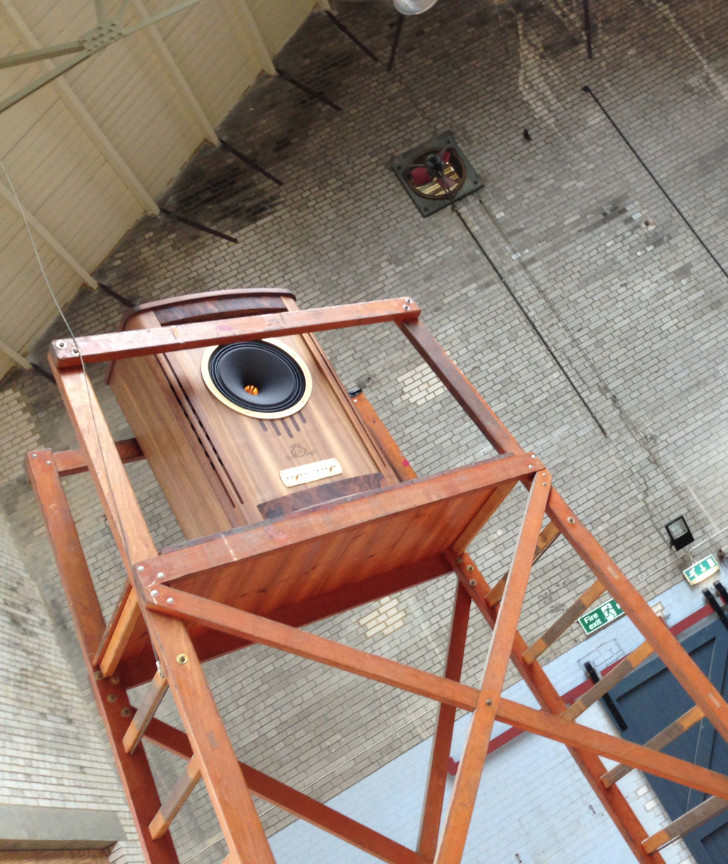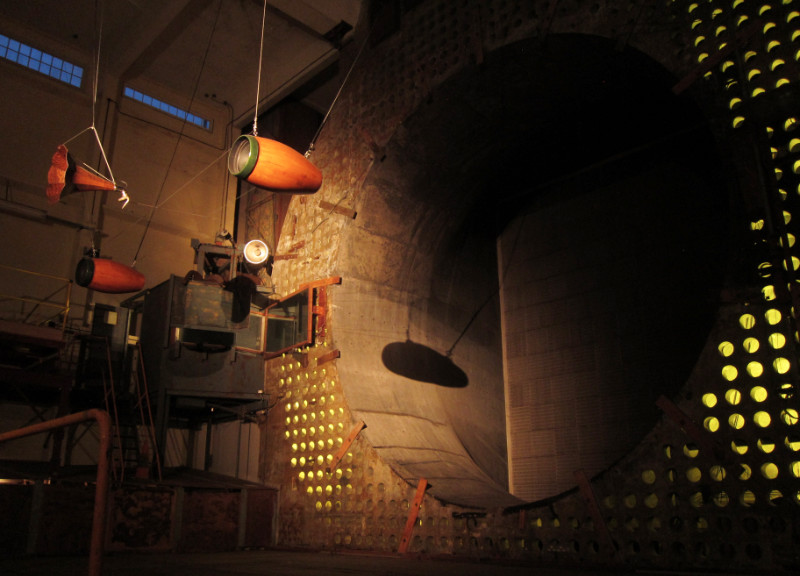
The Wind Tunnel
The Wind Tunnel
Flying into the Dawn
Site-specific commission designed to re-awaken the world’s largest remaining Farnborough Wind Tunnels, opening them to the public for the first time.
An immersive installation spanning a series of spaces over two buildings:
Q121 Full size Turbine test area, Q121 Massive inner vented air Tunnel space, R52a wooden Wind Tunnel and R52b space where a 3rd Wind tunnel used to live.
A commission to re-awaken the world’s largest remaining Wind Tunnels
Press Release
The vast 24 foot Wind Tunnel in building Q121, like a temple to Futurism, will be reawakened as an immersive experience through a new commission set across 2 buildings and 3 wind tunnels, by artist Thor Mcintyre-Burnie as a part of The Wind Tunnel Project, responding to its historic role and inimitable physical architectural and acoustic qualities.
The vast 24 foot Wind Tunnel in building Q121, like a temple to Futurism, will be reawakened as an immersive experience through a new commission set across 2 buildings and 3 wind tunnels, by artist Thor Mcintyre-Burnie as a part of The Wind Tunnel Project, responding to its historic role and inimitable physical architectural and acoustic qualities.
Thor McIntyre Burnie - Best Temporary Installation Award Winner : ProSound Awards / Tannoy 2015
*runners up were Björk’s Songlines; Imperial War Museum WWI galleries

Bird/Human, human/machine, war/wonder, threat /hope, there is a dichotomy to our relationship with flight. Walking past the colossal 24’ fan and suspended rig, one enters the vast return tunnel and is offered the choice to walk into the light or dark. Padding into the dark end we can re-attune our senses and explore the semi preternatural experience of this place and piece.
The second Building R52, has a very different feel to the cathedral like qualities of Q121 - it felt like it needed a form of pallet cleanser - so utilising the anechoic padded entry chamber we worked with food artist Carolyn Hobkins to create a little moment to savour the acoustic qualities of these alcoves, creating a moment of anechoic silence punctuated with popping candy.
R52a houses a huge wooden wind tunnel, suspended on legs snaking around the building. Treating this wooden structure like a giant instrument this intervention explores the edge of breath and a note, using 7-channels of sound & video projection to focus on the darker sides of this research facility. This more complex composition includes the Double Bass player from Farnborough Symphony Orchestra, who – like the voices you hear recorded in-situ in Q121- offers his own interpretation of the “ark-of-the-bombers”.

The contemporary equivalent of ‘the sound of the bombers’ seemed to me to be that of ‘drone warfare’. The development of flight, film and surveillance are so interwoven, I felt this notion could be explored by adding a further layer of film. The video you see inside the tunnel, projects recent research from a wind tunnel at Aichi Institute of Technology in Japan – where they are studying the flight of a Drone Beetle, for the development of Nano-drone technology.
I love the way the Drone Beetle footage is almost like a Muybridge motion-picture, yet is filmed at 10,000 frames a second with the latest high speed digital camera. This ability to zoom into and disrupt the laws of time & space seemed to be what these vast apparatus’s are about.
Surrounding this tunnel we hear a multi-channel recording of a starling bird roost, just after dawn as they begin to rouse, stirring the air of the hanger around this vast wooden beast.
The last space R52b, was a bright empty hanger where a wind tunnel used to be. This felt like it should be a space for play and release. Here we’re invited to fold our exhibition guides into paper aeroplanes and launch them into the sonicaly stirred air.
In this final empty space any physical structure introduced, became a sculpture, even the cables. In one corner an original Tannoy horn still hung, so working with Tannoy we mounted 4 of their flagship hand built speakers (at the fore-front of their own research), atop wooden aeroplane inspection towers. -Deliberately arranged to disrupt the surround sound set-up, they are turned so they explore the reflections of the space, conversing with the walls, panels, windows and old relics of themselves. The idea being to encourage people to listen through the architecture.. I like the idea of these old original Tannoy horns still affixed to the walls here, conversing with their latest heavy-weight off-spring. These horns are very much a part of this pivotal period of history, they are what made ‘tannoy’ a noun in our lexicon like ‘hoover’. – They are what gave voice to air-raid drills and Winston Churchill’s infamous public address.
In this final space the thrill and dynamics of a roller-coaster morph with the swooping murmeration flight of a Starling birds (drawing on previous collaborative work I did with wild-life sound recordist Chris Watson, studying a derelict concert hall and its massive starling colony).
This final space felt a like a place to look at the other side of the dichotomy of flight, and here I wanted to ask the question:
“Do birds ever fly simply for the thrill of it?”
As a part of the Launch event for The Wind Tunnels Project, I staged a series of short Orchitecture performances, spatially dispersing musical works and musicians around the building.
Taveners V. Advaita Vedanta ‘The Still Point’ from Requiem, spatially composed for Liverpool’s modern Cathedral. This piece became a reference for many of my trials in Q121. It seemed to so gently coax the cathedral like qualities of this space, rising up into that still space above the clouds. It’s a very short piece so we repeated it at intervals in the cycle of my recorded work, when it dropped down to just the nightingales. I placed the cellist inside the Return Tunnel next to the upper Wind Veins, then split and moved the 4 voices around the return tunnel, placing the lead Soprano beneath the giant 24′ fan.
The result was astounding and lifted the whole experience to another level, with many audience describing it as a quite profound experience. People said the hair on their necks raised each time.
The group of men from the RUSHMOOR MALE VOICE CHOIR, many of whom had careers on site and even in Q121, also performed their response to the bomber raid live within the wind tunnels filling the return duct with their voices and re-enacting their contribution to the recorded installation work. To quote a member:
“Never in my wildest dreams did I imagine I’d be back here 40 years on singing into the wind tunnel!”
Solo Cello, including Dvorak’s ‘Songs my mother taught me’ – As tribute to the BBC’s first live outdoor broadcast 90 years ago – the iconic duet between leading cellist Beatrice Harrison and the Nightingales, in her surrey garden, May 1924 – for a few occasions I also placed the principle cellist from Farnborough Symphony Orchestra (Robin Chave), within both the Q121 Return Tunnel and also R52 building (see image above). He played a series of short works which Harrson played in her garden on that fateful day 90 yrs ago. – Re-enacting the moment which enchanted the nation so much, that the BBC repeated the live annual nightingales broadcast every year for 18 years until the WW2 bombers cut it short for good.
This aspect of sound art is, as yet, not very well understood, and since no one is going to build cathedral-like spaces for artists like Thor McIntyre to play in, that’s all the more reason to open up derelict and disused industrial spaces to artistic exploration.
New Scientist Article about the project by Trevor Cox and Simon Ings
Pro Sound News Europe Magazine Cover Story
New Scientist Article about the project by Trevor Cox and Simon Ings
The scale of this site commission and the short time frame, required tremendous input from this core-team of creative specialists. – I would like to extend a huge thank you to them for helping make this beomoth of project, take flight.
PRODUCTION TEAM
Produced by Artliner : Tatiana Ojjeh, Victoria Luxem, Gemma Holsgrove
Exhibition Curator : (V&A) Salma Tuqan
Exhibition Design : BKKR – Design, Print, Web and Way Finding.
Lighting Design : Arnold Chan (Isometrix)
Food Artist : Caroline Hobkinson
INSTALLATION & CREATIVE TEAM
OLIVER AYLMER– Sound Design and Rigging
DAVID WAUGH – Sound Engineering, Sound Design and Rigging
DAVID DEGREEF-MOUNIER – Woodwork
DUNCAN WHITELY– Sound Design and Recording
STEVE PETCH– Choral Director and Musician Researcher
Rushmoor Male Voice Choir Conducted by Steve Petch.
MARK KUSIONOWICZ (tenor)
JOHN LOADER (tenor)
STEVE PETCH (tenor)
TERRY FIELDUS (baritone)
PETER SOUTHON (baritone)
ROGER BERRY (bass)
COLIN MOREY (bass)
ALAN RANDLE (bass)
Chris Watson (Ghost Roost & A Pier) – Earlier Collaborative recording projects.
Drone Bug Film: Many Thanks to Associate Professor Kazutaka Kitagawa, of Aichi Institute of Technology, Japan. Research into: Mechanics of Flapping Wing of Rhomborrhina Japonica, filmed in a wind tunnel using the Phantom v1610 camera.
Farnborough Symphony Orchestra: David Barnes (5 String Double Bass) & Peter Birkett (director).
For the Live Orchitecture Opening event:
Tavener: “Advaita Vedanta – The still point”, movt III from “Requiem”:
Conducted by : STEVE PETCH
EMMA MABIN (soprano)
DIANA VIVIAN (soprano)
BETH MABIN (alto)
STEVE PETCH (tenor)
ROBIN CHAVE (cello) – Farnborough Symphony Orchestra
This amazing architectural and historic place would not be here today, if it were not for the FARNBOROUGH AIR SCIENCE TRUST (FAST) – they deserve a 24′ medal !!
Photograph Credits
Shaun Jackson
ForgottenHeritagePhotography
Ally Robinson


















